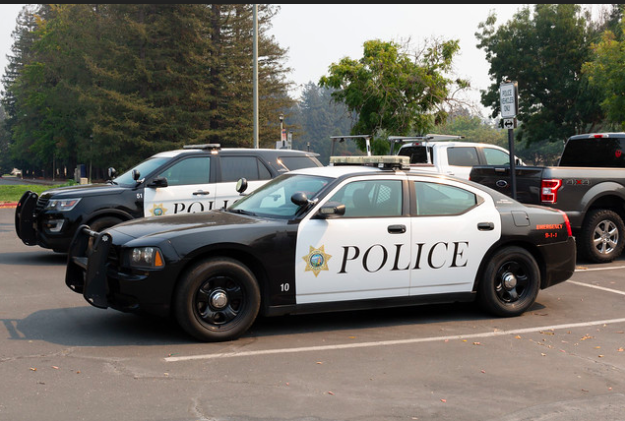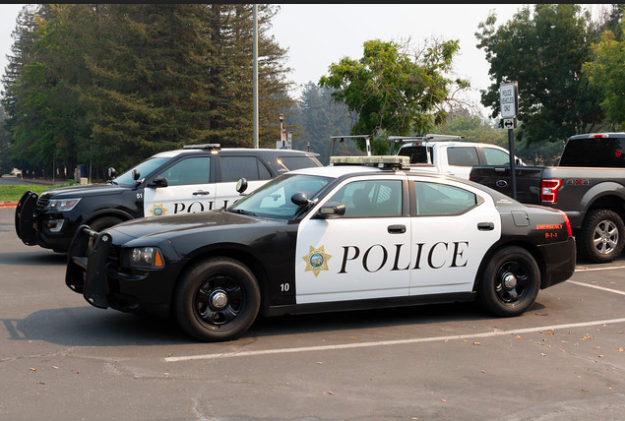In spite of an 85% drop in students living on campus, and 97% of fall 2020 classes being taken online, the Sonoma State University Police Department has had its hands full taking care of campus facilities.
Since the transition to remote learning in mid-March, Sonoma State’s campus has been used for COVID-19 alternative care units, housing the homeless population to prevent transmission of the virus, and as a wildfire evacuee shelter managed by the Red Cross in coordination with Sonoma County Emergency Management.
The university signed a contract to use dormitory housing in Verdot Village and Sauvignon Village and the Cooperage as alternative care units in April, in conjunction with Sonoma County Department of Health Services, to allow health care workers to use space on campus for an Alternate Care Site. In a letter from July 1, the university called on the county to vacate facilities to give ample time to clean and prepare for students returning to campus in August and to focus on its mission of higher education.
Interim Police Chief Jeffrey Weaver, a 28 year veteran of the Sebastopol Police Department, said the extra activities on campus have been “a big production.”
Despite the campus being used to provide assistance to a variety of individuals and organizations, the normal day to day resembles more of a ghost town.
“It feels like a holiday or Sunday might normally feel but it’s everyday,” said Weaver.
Normally around 3,000 students live on campus, but with social distancing orders, remote learning and many students choosing to live at home to save money this semester, there are only around 450 students currently living in the dorms. The upside of less students living on campus is all residents get their own bedrooms and bathrooms. This is also in compliance with COVID-conciencious guidelines.
“We still have people living and working on campus. It is our job to serve, protect and provide a safe, welcoming learning environment,” said Weaver.
He added, “It wouldn’t matter if there were only three people living on campus, we would want to make sure those three [live] in a safe environment.”
The role of the Police Department has remained the same as it was pre COVID-19 according to Lt. Lee Swicegood who has worked for the University Police Department (UPD) for 16 years.
In an email Swicegood wrote, “With social distancing and less students on campus, we ,like everyone else, are forced to adjust to interacting on a limited/distanced basis with staff, faculty and students. The police department has remained the same [as pre-covid] in that we are working the same hours and fulfilling the same purpose…Officers are patrolling 24/7, 365 days a year to ensure that SSU remains a safe place.”
Due to budget constraints exacerbated by the novel coronavirus pandemic, the university had to eliminate the role of a 14th officer for the UPD. That role was vacant when the new budget went into effect for the 2020-21 academic year. The department will be operating with only 13 sworn peace officers on staff under the new budget.
“It is ideal to have 14, but we could do 13. With less than 13, there are weaknesses in safety, staffing and have to do overtime, which is not good for budgeting….when we run short, people get hurt, fatigued and the last thing we need is somebody getting hurt,” said Weaver.
The responsibility and visibility of the UPD has had to increase, to make up for a loss of nearly 10,000 “eyes,” or people, that would normally be on campus during the week. Around 9,000 undergraduate and graduate students normally attend SSU with around 1,400 faculty and staff members regularly working.
On this topic, Swicegood explained, “There are less people, vehicles, bicycles, computers, etc. currently on campus, therefore there are less people, and less property to commit crimes against. We are also being extra vigilant, because criminals know that there are less people on campus and less eyes to see and report suspicious behaviours.”
In 2020, historic protests against police brutality broke out across the state, country and internationally. Protesters had demands such as defunding of police departments, ending of racial bias and accountability for violence and injustice. Despite a tense environment between law enforcement and the general public, Chief Weaver is hopeful about how the SSU community will come together once in person again.
“After the murder of George Floyd- and I specifically say murder- there has been a national discussion on race and how police intereract with people of color. All CSU [California State University] police chiefs are doing steps to review all policies and training [currently] in place,” said Weaver.
In a joint letter to the CSU community on June 4, all 23 CSU police chiefs issued a joint statement “Standing in Unity” and were “…united in denouncing excessive use of force and lack of due care for human life.”
In the letter they stated, “We will continue to engage in open dialogue, review our practices, revise our training, improve our cultural education, enforce accountability, collaborate with our community leaders, and maintain transparency.”
Because of social distancing, interactions with the public have had to be limited, which, according to Lt. Swicegood, is one of the best parts of the job for most officers. Normally the UPD will host many events throughout the year including forums during orientation for incoming students and their families.
He said, “Normally this time of the semester and after [limited interactions in] summer, officers can’t wait for students to get back. Our officers are very anxious for people to return…Our department is eager for personal interactions again.”
It is unclear when most students and faculty will be returning to campus. CSU chancellor Timothy White announced on Sept. 10 that all universities in the CSU system will continue with almost fully virtual instruction for the semester starting January 2021.





![[Both photos courtesy of sonoma.edu]
Ming-Ting Mike Lee stepped in as the new SSU president following Sakakis resignation in July 2022](https://sonomastatestar.com/wp-content/uploads/2024/04/CC4520AB-22A7-41B2-9F6F-2A2D5F76A28C-1200x1200.jpeg)



























